Power Forward
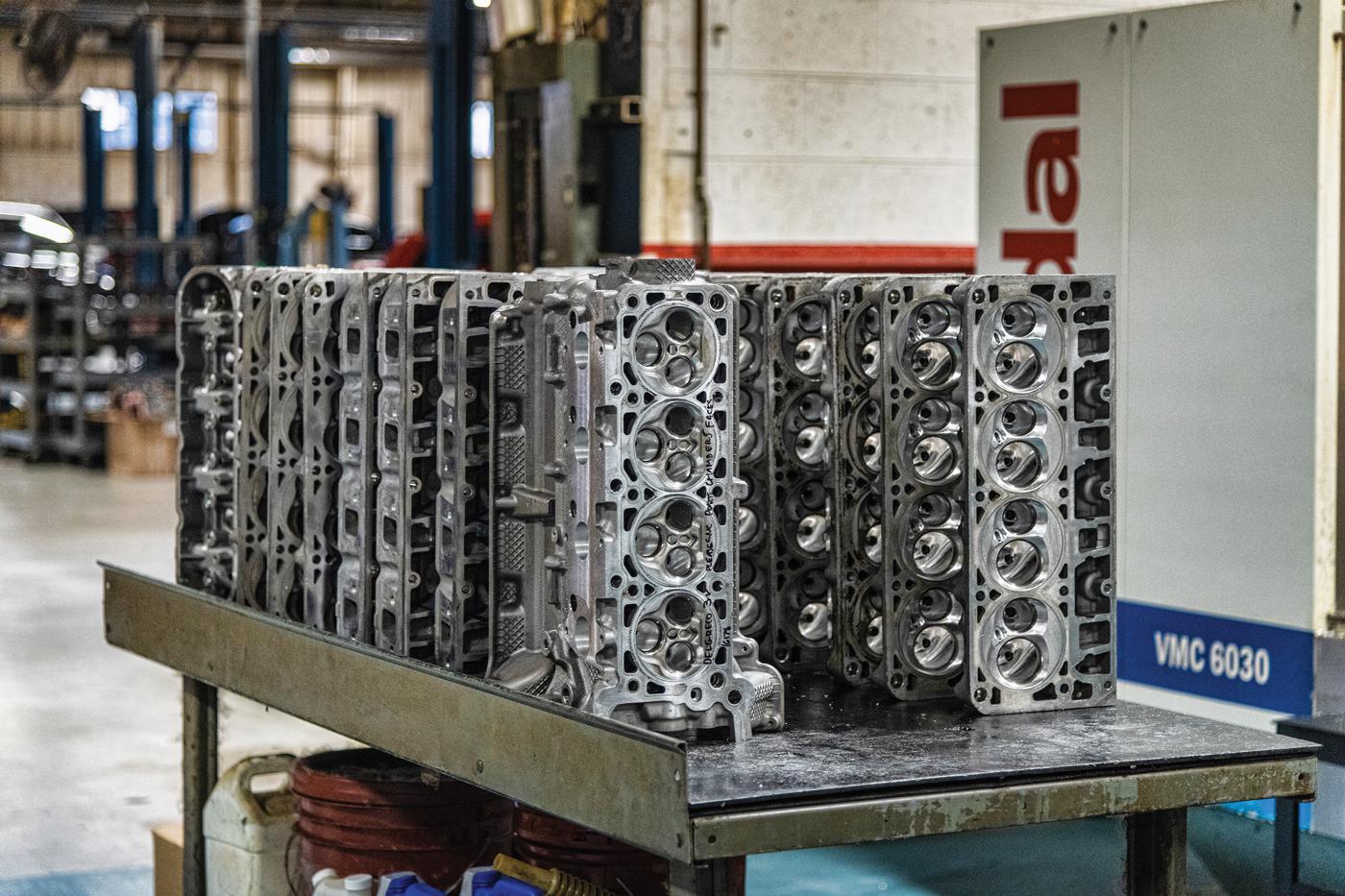
Cylinder head development drives winning engine combos, and manufacturers are busier than ever feeding the demand for performance.
Cylinder head manufacturers, while keeping up with the frantic sales pace experienced by many speed merchants during the pandemic, also found time to develop new products and branch out to design supporting components.
Following one of the craziest years on record in terms of sales versus restricted racing opportunities, new engine applications along with the tenacious growth in Outlaw and other doorslammer drag racing classes, as well as the continued popularity of classic platforms, are pushing development into exciting new territories.
“We’ve been busier than ever, by far,” said Keith Petelle of High Velocity Heads, Knoxville, Tennessee. “We are really grateful for that, but it’s been an amazing year, and right now it’s wild.”
High Velocity Heads doesn’t manufacture its own heads; rather, the shop modifies existing castings or works directly with manufacturers to improve the flow of a casting that can then be private labeled, or otherwise sold through the original manufacturer or directly from High Velocity. One of its current projects offers big block Chevy racers another choice in a very crowded market for that platform.
“We’re working with World Products on an exclusive for their big block iron head,” said Petelle. “It’s got a 360cc intake runner. We also do our own smaller version in a 340cc runner. A lot of those customers are boaters and truck pullers.”
Jack McInnis of World Products in Louisville, Kentucky, confirmed the collaborative effort. “We are developing new CNC porting programs for our iron small and big block heads. It’s been a while since we’ve offered ported iron, and these new programs flow a lot of air,” McInnis promised. “They will be great choices for marine use where salt corrosion is a big concern with aluminum heads, and for circle track and pulling applications, as well as heads-up and bracket racing in situations where weight is not a top priority.”
“We have another deal with World Products by CNC porting their Motown 220cc small block Chevy head out to 230cc,” added Petelle, who noted that some SBC castings are getting hard to find because the Chevy is still so popular. “We bought up the last of the EQ iron 200cc heads so we would have some heads to port and sell.”
High Velocity Heads recently purchased a new CNC machine to work with both iron and aluminum heads. “The aluminum goes a little faster but it’s not tremendously different,” said Petelle. “We’ve got pretty good tooling for the iron and we’ve really got it figured out. A lot of people won’t cut cast iron, and that’s kind of why we got into it. Some of the markets are so competitive, so we wanted that niche.”
Also riding the wave of BBC popularity is Dart Machinery, which recently overhauled its 20-degree head for big blocks. “We have a couple different versions,” said Steve Arent of the Troy, Michigan-based supplier. “In one of them we shrunk down the port—from 451cc down to 409cc. Obviously the airflow was affected, but with the smaller runner the velocity in the port is just fantastic. We’re having really good success with customers building in the 470- to 525-cubic-inch range.”
Arent said off-road trucks are making more than 900 horsepower with naturally aspirated 470-cubic-inch engines using this head. “It has low-end torque and [is] making more power throughout the entire bandwidth,” said Arent. “We have another customer who has bolted these heads on his supercharged marine engines and he’s picking up 75 horsepower.”
It’s not just Chevy big blocks drawing attention from cylinder head manufacturers. Edelbrock, which recently moved its headquarters from California to Olive Branch, Mississippi, is releasing an improved version of its big block Oldsmobile head in 2021. Upgrades include modifications to the combustion chamber and ports in addition to providing flexibility for racers to raise the ports with their own designs for more performance.
“We will follow that shortly with the release of a new head for the Olds small block, an item not previously in our product line,” said Matt Gamble. “Design features mimic the BBO head, but with a chamber sized for the small block. Both heads feature a fuel pump relief machined into the casting, allowing for the use of a mechanical fuel pump.”
Even with the popularity of traditional platforms, the LS engine continues to drive development for late-model customers. Edelbrock’s sister company, Racing Head Service (RHS) in Memphis, Tennessee, now offers a Pro Elite LS3 head and a small-bore cathedral-port head.
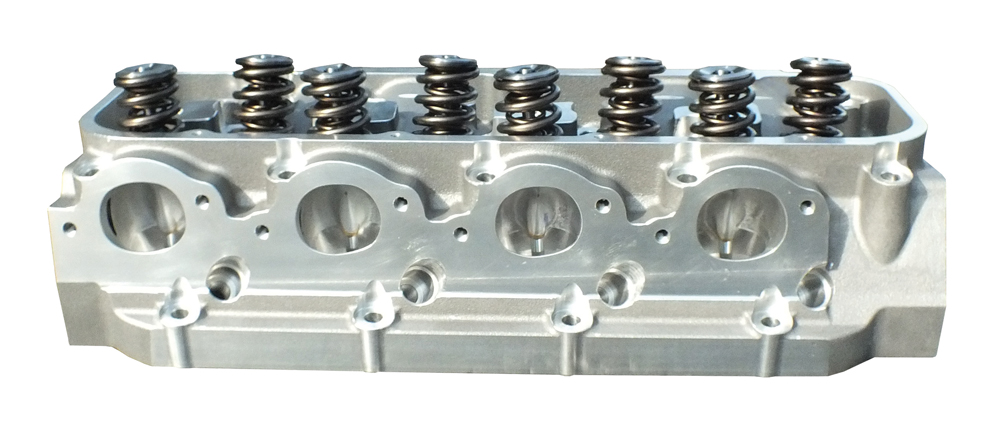
“No longer will you need to scour the salvage yards looking for used 243 or 799 heads,” said Gamble. “You can get better performance and more reliability with new Pro Action cathedral port heads. And the LS3 head utilizes the six-bolt head design, making them compatible with RHS LS race block and GM LSX block.”
Just don’t count out the venerable Gen I Chevy small block. “Even with the LS hype, small block Chevy has never given away its top spot,” said Tim Torrecarion of Air Flow Research (AFR), Valencia, California. “Our most common builds are 383, 408, 418, and 427 cubic inch. For us, that’s anywhere from a 195cc intake runner head up to 220cc. And right behind that series in popularity is the small block Ford.”
“Our most popular head is the 11R for the small block Ford,” echoed Josh Cook of Trick Flow Specialties, Tallmadge, Ohio. “We offer different options in port volume and chamber size. For value and performance on the dollar, it’s as good as you can get.”
Trick Flow and AFR are two companies that in addition to offering new or improved cylinder heads, are designing supporting components to help the customer assemble an optimum package.
Trick Flow recently released three intake manifolds designed to match corresponding heads from three different engine families. “We want to offer the appropriate intake options,” said Cook, adding that intakes are available for the Ford FE tunnel wedge, small block Mopar, and small block Chevy.
AFR has three new camshafts designed to work with its LS3 Mongoose head. “These are all streetable cams,” said Torrecarion, noting that dyno testing produced power levels from 560 up to 590 horsepower with between 19.8 to 17.1 inches of vacuum at idle. “We’re just trying to make it easier for the customer to make power.”
Making power—that’s what’s happening in Pro Mod and other professional classes. Alan Johnson Performance Engineering in Santa Maria, California, just released its Stage 6 Muscle Head for the Chrysler Hemi platform.
“It’s designed for the Pro Mod arena,” said Rick Wilkinson. “Whether using a ProCharger, supercharger, screw charger—any boosted setup. We’ve moved the valves around and improved the port flow. Also reduced the chamber size. It’s basically small iterations we’ve learned over the years from the earlier versions. We sent the first versions to Proline Racing for dyno testing, and they showed a substantial increase in power.”
Although high-end racing classes will draw much of the attention in engine and cylinder head development, appealing to the budget racer is still on the minds of leading manufacturers. Brodix recently released its 23-degree IK 215 for the small block Chevy. It features a 215cc intake port and 64 or 70cc combustion chambers that can accommodate different fuels.
“IK, like in Iron Killer,” explained Mark Fretz from the Mena, Arkansas-based company. “It’s a budget race head for those who want to make 575 horsepower and go bracket racing.”
The IK 215 is designed to fill a gap between the upper end Dragonslayer 225 head and the IK 200. It comes assembled with stainless steel 2.08/1.60 valves, and spring options are designed to accommodate both solid and hydraulic roller camshafts.
One cylinder-head specialist is taking his product to the track to help develop more power. Mike Weinle of Weinle Motorsports in Cleves, Ohio, bought an unused Sonny Leonard mountain motor to go Pro Stock racing, but first he’s hitting the dirt tracks with a new Rocket car powered by a small block Chevy with a modified R0X head from 1 Way Technologies in Washington, Indiana.
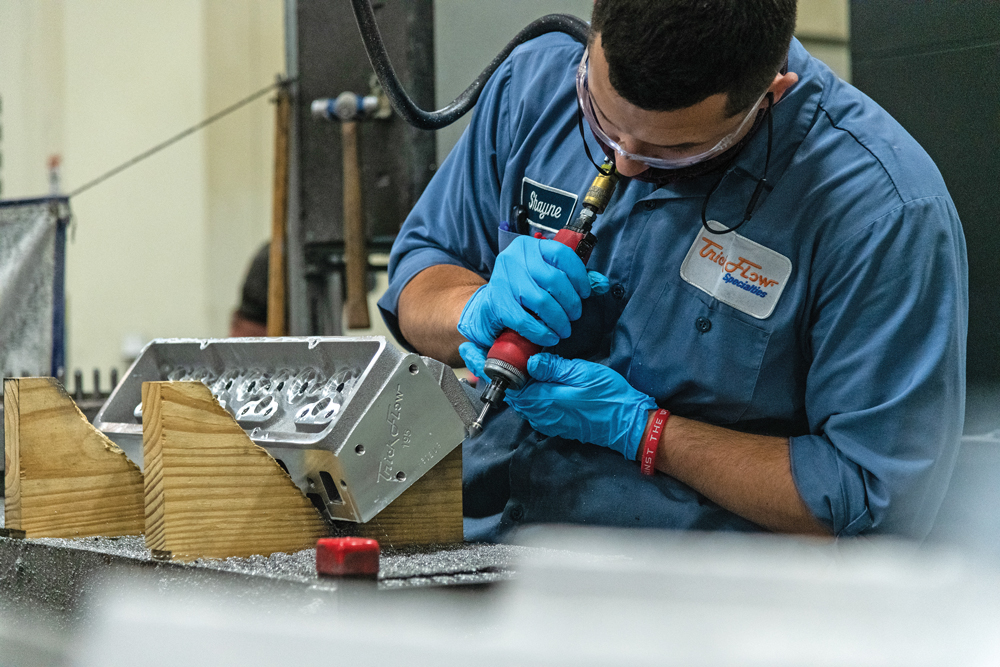
“We did some work with it,” said Weinle. “I got a new port for it that’s 20 to 30 cfm better and got the shape to where we like it. Also made changes to a billet intake for it, and now I’m working on a cam for it. What I’ve found in my dirt car is that the most important thing is acceleration. I can look at two motors making the same power on the dyno, and one is three car lengths faster than the other on the track.”
For the Pro Stock engine, Weinle is focusing on the exhaust ports and also taking advantage of a 75-mm camshaft core and “giant” lifters.
“So we can make a more aggressive camshaft,” he added. “We’re getting ready to put it on the dyno. I’m looking for 2,150 to 2,200 horsepower.”
The Leonard head is a hemi design, and Weinle is also looking at building a mountain motor with an AJPE wedge-style head—but those plans are hush-hush at this point.
At 1 Way Technologies, engineers are developing a new midget head to compete against the Toyota and Stanton engines.
“We’ve redesigned a CNC program for the All-Pro 10-degree casting,” explained Chris Grace. “We’re able to get the blocks from Australia and then put our head on it. We took the baseline for what we do to the heads on a 410 sprint car and modified that shape. It’s actually a casting we have All Pro machine to our specs. It’s advertised as an 11-degree head and we have them move it to 10 degrees for us.”
Called the Type 71, this cylinder head made its debut at January’s Chili Bowl with “pleasing” results for the first customer.
“We’re very close with a few things we’re going to tweak on it,” said Grace.
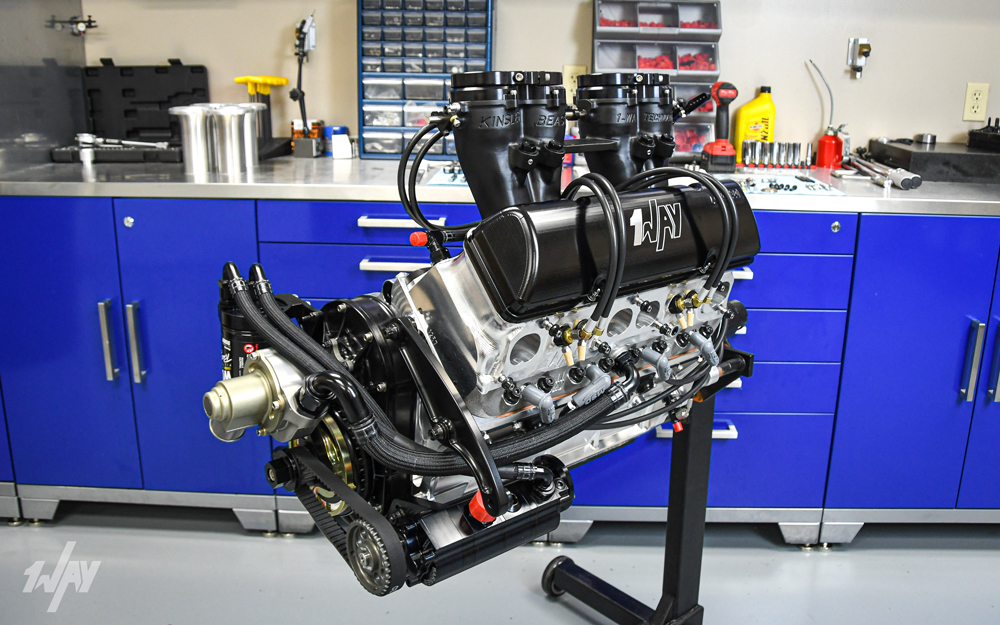
As mentioned earlier, 1 Way has an ROX head made from their own original hybrid casting. “We engineered a single casting that can be machined either as a SB2.2 with a 4.400-inch bore center or the ROX with a 4.500-inch bore center,” Grace added.
Nostalgia gassers are also getting attention from 1 Way, which teamed with Brodix on the -10 SR I 21-degree head for small block Chevys. It was approved by the Southeast Gassers Association (SEGA) and was on the engines of the 2020 A/Gas and B/Gas champions.
“We requested Brodix to modify an existing casting and qualify them to 1 Way specifications so we could CNC port the castings to our design,” explained Grace about the -10 SR I casting. “We worked very closely with SEGA on that head, and we are the title sponsor of the annual race at Wagler Motorsports Park in Lyons, Indiana.”
Limited Development
Cylinder head development is a main driver of today’s ever-escalating power increases—even when boost is involved. Which is why sanctioning bodies are always tightening the envelope that manufacturers can design around.
“Everybody’s trying to increase power, but in a lot of it you’re always constrained by the rules,” said Wilkinson. “For our Top Fuel heads, the window is so small for improvement. We’re basically making the same product we’ve made for the last seven years.”
Even in the Outlaw classes where it seemed at one point there were no rules, promoters are starting to strangle engine builders with limits or piling on weight to the cars that show promise.
“We do a lot of heads for the heads-up street race-type classes,” said Fretz. “We’ve done both 4.5 and 4.4 bore centers. One of the most popular heads right now is the BD 2300 on our 500-plus cubic-inch engines. But I have to be careful. These heads-up guys are real secretive on what they do.”
Of course, some rules are meant to be stretched. High Velocity Heads is often approached by racers required to run stock-style iron heads.
“Yeah, we can port them and disguise them,” said Petelle. “We do the crate engines and the spec heads. You’re looking at 20 to 25 more horsepower.”
Even some of the manufacturers are holding their cards close to the vest. Dart is hinting that a Big Chief 3 cylinder head is in development with a “bigger runner, bigger exhaust port, and smaller combustion chamber.” The head will also feature revised rocker-arm mounting.
“It’s a pretty bad-ass piece, the way it’s coming together,” said Arent. “We’re just teasing people with it right now. It should come out late third quarter, early fourth quarter.”
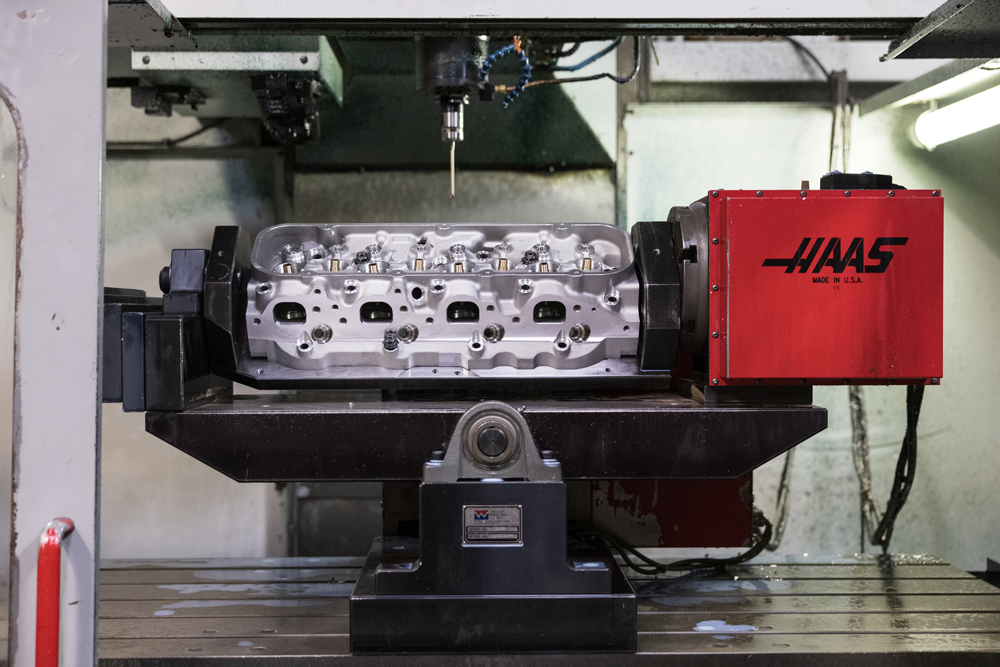
Another Dart exclusive done in conjunction with a “really big-name engine builder” is the 20X cylinder head that works with a revised lifter-bore pattern that straightens out the pushrod angle. It also allows for a single rocker shaft instead of individual rocker stands.
“It really helps stabilize the valvetrain,” added Arent.
Finally, manufacturing and development are getting a boost from the latest tech.
“Newer technologies like the ability to 3D print sand cores helps shorten development times for castings, and we can also refine the designs before committing to expensive foundry tooling,” said McInnis. “We have made it a priority to keep all of our development and manufacturing in the United States. We believe this is important for our customers and allows us more immediate control over manufacturing.”
“While not really a new process, the bedrock of CAD/CAM is essential to being able to deliver high-quality, high-performance products at a competitive price point,” said Gamble. “Also, there are some really interesting things going on with 3D printing. We will likely see the adoption of more 3D printing processes, from printed sand molds to topology optimization, influencing the future of cylinder head design.”
“We’ll develop a port by hand, then laser scan it and continue the development in CAD. We can also scan a stock head to get a baseline of valve locations and other data to reverse engineer,” Cook told us. “Then there’s no replacement for flow bench testing to fine-tune that port. But flow numbers don’t always equal real-world performance. Great numbers may not mean horsepower for your application. That’s why we also test heads on the dyno.”
SOURCES
–
1 Way Technologies
1way-tech.com
Air Flow Research
airflowresearch.com
Alan Johnson Performance Engineering
alanjohnsonperformance.com
Brodix
brodix.com
Dart Machinery
dartheads.com
Edelbrock
edelbrock.com
High Velocity Heads
highvelocityheads.com
Racing Head Service
racingheadservice.com
Trick Flow Specialties
trickflow.com
Weinle Motorsports
weinlemotorsports.com
World Products
pbm-erson.com
 MEMBERSHIP LOGIN
MEMBERSHIP LOGIN JOIN PRI
JOIN PRI


